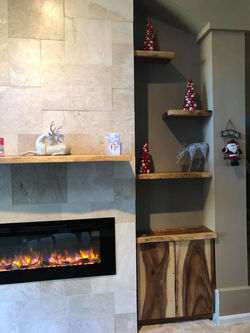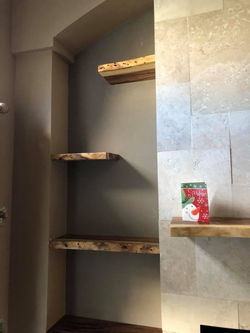
Custom Live Edge Wood
Conference Tables, Benches, Counter Tops, Bar Tops, Wall Art, Coffee Tables, Shelving & Much More!
With our capabilities your only limitations are your budget and imagination.
About our Wood:
We are the "Source" for the rare and very sought after Hawaiian Monkey Pod Wood!
Monkeypod (Samanea saman)
Common Name(s): Monkeypod, Monkey Pod, Raintree
Scientific Name: Albizia saman
(syn. Samanea saman, Pithecellobium saman)
Tree Size: 100-125 ft (30-38 m) tall, 3-4 ft (1-1.2 m) trunk diameter
Janka Hardness: 900 lbf (4,010 N)
Crushing Strength: 5,790 lbf/in2 (39.9 MPa)
Color/Appearance: Color tends to be a golden to dark brown, sometimes with darker streaks. Sapwood is usually thin and yellow/white, clearly demarcated from the heartwood. Monkeypod is sometimes seen with highly figured curly or wild grain patterns.
Grain/Texture: Grain is usually straight, but can also be interlocked or wavy. Texture is medium to coarse, with medium to large open pores and a moderate natural luster.
Endgrain: Diffuse-porous; large to very large pores in no specific arrangement, very few to few; solitary and radial multiples of 2-3; heartwood deposits occasionally present; narrow rays usually not visible without lens, normal spacing; parenchyma vasicentric, lozenge, and confluent.
Rot Resistance: Rated as durable to very durable regarding decay resistance, Monkeypod is also resistant to most insect attacks.
Workability: Monkeypod is generally easy to work with both hand and machine tools, though any interlocked grain may result in fuzzy or torn grain during planing operations. Glues and finishes well.
Odor: No characteristic odor.
Allergies/Toxicity: Although severe reactions are quite uncommon, Monkeypod wood dust has been reported as an eye irritant.
Pricing/Availability: Monkeypod usually trends a little bit pricey compared to other exotic woods. Boards with figured grain patterns are much more expensive.
Comments: Named for the spiral-shaped fruit pods which the tree bears. Outside of Hawaii, one of the most common names for the species is Raintree, which is due to the leaves’ tendency to fold up at night or during periods of rainfall, allowing rain to pass through its broad canopy to the vegetation below. Trees are commonly planted in tropical regions as an ornamental shrub or shade tree.
Monkeypod is called by many different names in many different cultures, and its lumber is likewise used for a number of different purposes depending on the locale, ranging from utility wood and construction purposes to fine furniture.
None available.





 |  |
|---|---|
 |  |
 |  |
 |  |
 |  |
 |  |
 |  |
 |  |
 |  |
 |  |
 |  |
 |  |
 |  |
 |  |
 |  |
 |  |
 |  |
 |  |
 |
Call Today for a FREE Quote!
954-860-4286
 |  |  |  |
|---|---|---|---|
 |  |  |  |
 |  |  |  |
 |  |  |  |
 |  |  |  |
 |  |  |  |
 |  |  |  |
 |  |  |  |
 |  |  |  |
 |



